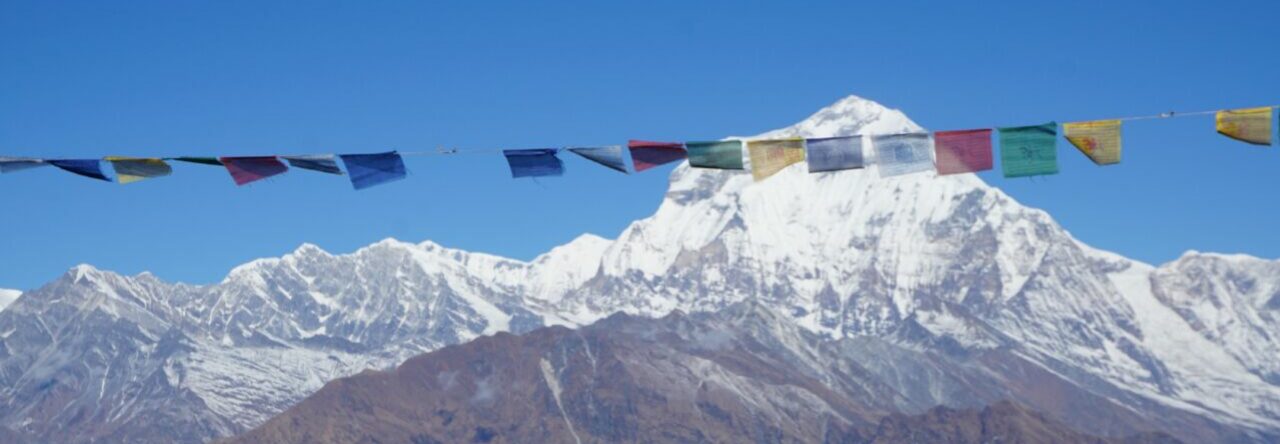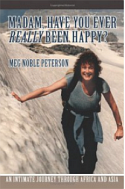James and I took the “Sham” route, starting on May 31st, and spent five days exploring the countryside, climbing over four high passes, and encountering a variety of weather–from baking in the endless sun to snow-flurries on top of Mabtak La (also called Bong Bong Chan La) the last day. La, of course, means Pass, and we always were greeted with dozens of prayer flags and white katas to celebrate our accomplishment.
As with this and other trips I’ve taken in Ladakh, I have never been anywhere that can boast of more varied scenery or as many different rock formations crammed into a small area–small compared to the vast spaces we Americans are used to in the western U.S. One moment you’re looking at shale and splintering rock that was at the bottom of the ocean 50 milion years ago, and a few meters later you’re gazing at convoluted sandstone moonscapes reaching hundreds of feet into the river valley, hanging rocks resembling Inca statures, or swirling lava with orange striations. Sand flows between shiny coal-black outcroppings or purple and green folds bereft of any vegetation, an ever-changing pattern of stone that amazes and delights.
The chanting began, and then the drums started beating very low at 5 AM on the day our big adventure began. Stanzin Lhawang, our friend and guide ([email protected]) picked us up in a van, driven by Phunchog, a cheerfull Ladakhi, who drove us, first, to the Hindu Temple, Gurdwara Sri Pather Sahi Ji, dating from 1517, and then delivered us to Liker, site of the famous Liker Monastery at 11,000 ft. The original structure was built in 1065, but later destroyed by fire and rebuilt in the 15th century. Like so many monasteries in Ladakh, it has the flavor and beauty of the Potala Palace in Lhasa, Tibet.
We stayed at a lovely hotel, The Lhukhil, and since we were the first guests of the season, enjoyed luxury at reasonable rates. After this is would be homestays, where we lived in the homes of Ladakhi farm families in small villages along the trekking route.
The first afternoon we took a strenuous walk to the monastery high on the hill. I felt as if I were bushwacking most of the way up and could only sympathize with the monks who did the climb frequently. Stanzin’s great uncle, a monk, had just died, so his family was gathered there and a special puja was being offered. We sat in the chapel with the monks, listening to the chanting, the long, mournful horns being blown, and the two large drums as they accented the end of each chant. As is customary, chai, or sweet milk tea, was served.
That evening I spent talking with a ten-year-old and her cousins, who were eager to speak English and sing songs, which I recorded and played back. We had a lovely time and would meet the next morning at breakfast to practice reading some of the stories they had written in their notebooks. I was amazed at their proficiency and at the complicated stories they were given. And the handwriting was as good as any I’ve seen in a U.S. primary school.
I spent the next few days climbing over trails slow as a tortoise, sliding down steep scree paths and walking with terror along high cliffs. I felt that I was beginning to get over my fear of “exposure,” which had dogged me in the Himalayas, but, mostly, I just crept ahead, knowing that one false step would mean curtains. I was not ready for any curtain that wasn’t on a Broadway stage!
We reached the small town of Yangthang at 3 PM and I clambored up side alleys until I met the donkey driver, Stobden, who led me to the Norboo Guest House, where we would stay for two days. Our room was ample, but the facilities were Ladakhi, which gave us an authentic taste of native culture. I actually enjoyed the bath room, which consisted of a large bucket in which you could wash, and even soak your feet, plus basins for such activities as brushing your teeth. When you finished you simply poured everything down a drain in the corner. The toilet (a separate room) was a rectangular hole with dirt and ashes around it. And, of course, a shovel handy.
The community had about fourteen families, and we witnessed a type of town council meeting across the alley from our room. The Indian government was about to do something the citizens did not like, and we would hear about it at dinner. Coincidentally, this is the family of another Stanzin, one of the young men at the internet cafe, with whom I had become friendly, and who was overjoyed when we told him about eating and talking with his family. We also took pictures which he eagerly downloaded.
My last day of youth before my birthday was spent climbing to the Rizong (Rizdong) Monastery, another Potala-like structure built into a hill, with a large school at the base for young monks. There was a great deal of construction going on and the paths to the buildings were slippery and steep. But I enjoyed the labyrinth of tunnels and alcoves secreted in the upper stories. I even got lost on one of the roofs trying to find a passable stairway down. Stanzin, who has relatives all over Ladakh, found that one of his cousins was in charge of the kitchen, so we were given a lunch of rice and dahl that sustained us on our way back to Yangthang. At one point we stopped at a lush grove of apricot trees (not yet ripe) by a rushing stream. The long grasses that I had so liked in the Numbra Valley were lining the stream like the hair of a shaggy yak.
At dinner there was grandpa, turning his prayer wheel and chanting, and several other members of the family, including a three-month old baby. After the meal we all took turns churning butter. I have the photos to prove it!
I shall end with June 3rd, my birthday. On this day we headed up the Dsermangchan La, meaning thorny path, at 11,500 ft. By noon we were in the village of Hemis Shukpachan. I had never seen so many stones in my life! Evidently this is the way all the fields had looked at one time. There were stone walls and stupas everywhere, and a small monastery on the hill. We visited a primary school in the afternoon, and James became embroiled in a fast game of frisbie with the youngsters.
This time we stayed at the Diskit Guest House, and got to know the family during long conversations in the evening. In communities like this there are always conflicts between parents, who educate their children, but then want them to stay home and continue the family tradition, and the children, who are also drawn to the family, but have professional lives calling them.
I was resting in the late afternoon, when Stobden burst in and indicated that I was wanted by the stream down below. There were James and several new friends “celebrating” MY birthday with one bottle of beer cooling in the stream. But what about ME? The bottle was passed around and, suddenly, out of nowhere appeared six more Ladakhis, even a doctor, who seemed impressed that I had lived so long. Hugs all around and another bottle of beer. The brand was fitting…Grandfather’s. How can you not be happy with so many exhuberant, happy males congratulating you?
James and I are heading for Hemis Monastery and Shey Palace tomorrow, so I shall finish relating the trek and an exciting, but disastrous trip to Tso Moriri on the next blog. Don’t want to make the postings too long, do I?
One last note: I’ve mentioned several times that the homes here have very low doors and the monasteries are even lower. There are many theories about this and perhaps you can add a couple more. First, it’s very cold here in the winter, so you want to conserve heat by having smaller openings and higher sills. Or, as one young lady told me, the low doors keep the ghosts out, because ghosts can’t bend down. Hmmm, that seemed a bit far-fetched. But the last one is that you have to bow down, so you show respect for those in the room you are entering. I like that the best!
I’m off to absorb more of the perfect sun that shines every day, all day in this beautiful country.

